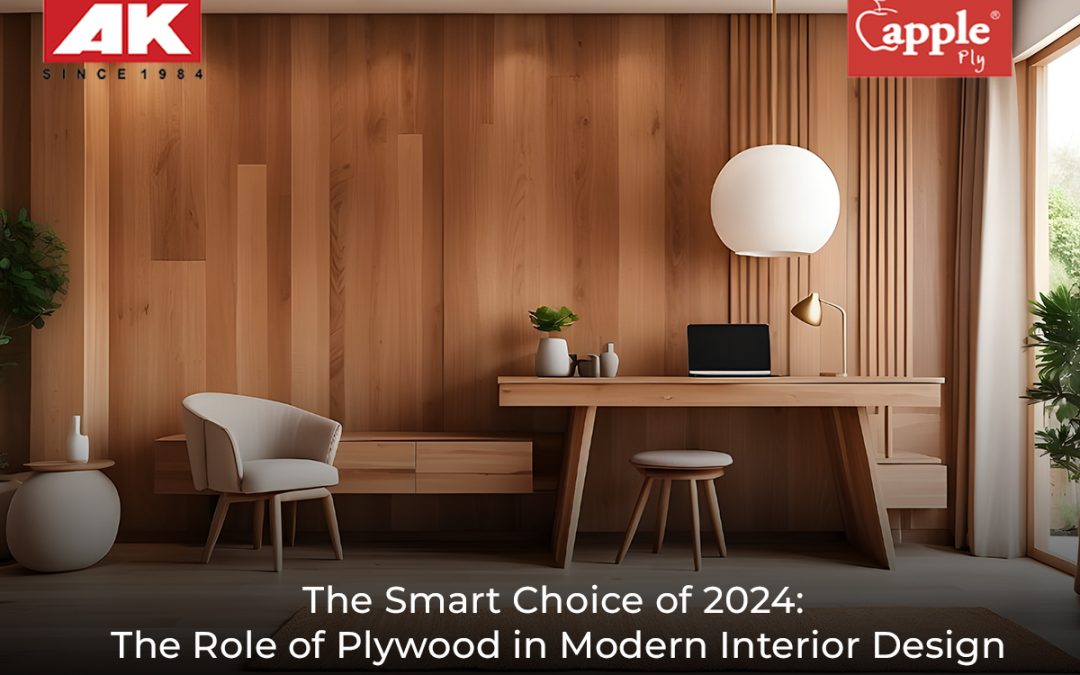Plywood, that was once a humble building material, has evolved into a modern interior design element. Due to its unmatched versatility, strength, and aesthetic appeal, the global plywood market is expected to reach $152,527.58 Billion by 2030! This makes it clear that plywood is not just a construction commodity; it’s a creative force driving the future of plywood in modern interior design.
Through this blog, let us give you a quick understanding of the innovative roles plywood plays in shaping the aesthetics and functionality of modern living environments, illustrating why it’s the go-to material for contemporary design.
The Role of Plywood in Modern Interior Design
Besides being an excellent choice in terms of versatility and durability, plywood plays multiple roles in interior applications, including:
1. Wall Paneling and Flooring:
Plywood is used for decorative wall paneling and flooring to create a warm, and organic feel in living spaces. It can be finished in a variety of textures, stains, and colors to match any design style, from minimalist to a rustic look. Plywood’s ability to adapt in any corner by possessing a variety of styles makes it the chameleon of the design world, always effortlessly blending in wherever it’s needed while also standing out.
2. Furniture and Millwork:
Plywood is ideal for crafting custom furniture pieces and built-in cabinetry, all credits go to its strength, flexibility, and ease of customization. Designers have been using it for years to create unique tables, chairs, shelving, and storage units that add character to any room.
3. Ceiling Treatments:
Plywood is not limited to areas you can touch and feel, it’s also used to create stunning ceiling designs, such as coffered or slatted ceilings, which add depth and texture to a room. Its lightweight nature makes it easy to install, and it can be finished to match or complement the room’s decor.
4. Partitions and Room Dividers:
Plywood is a top choice for crafting custom partitions and room dividers, perfect for anyone craving privacy or looking to transform a studio into a multi-room home. Its versatility shines as it can be cut into various shapes and sizes or paired with materials like glass or metal, providing the ideal balance between privacy and openness in open-plan layouts.
5. Acoustic Panels:
Plywood is used to create acoustic panels that improve sound quality in spaces like home theaters, studios, or offices. These panels can be customized with different patterns and finishes to give a dash of aesthetic appeal while it serves its purpose of sound absorption and control.
6. Accent Walls and Features:
Designers use plywood to create eye-catching accent walls or unique design features such as shelving units, headboards, and wall-mounted decor. The natural grain patterns of plywood offer a rustic and vintage look, adding a desirable aesthetic to your dream bedroom.
You might also want to read: A quick and easy step-by-step guide on how to glue plywood:
7. Doors and Window Frames:
Plywood is often used for creating interior doors and window frames due to its strength and ability to be crafted into various styles. If you’re looking to give your house’s door or window frame a revamp, then choose plywood for a stunning upgrade that combines practicality with aesthetic charm!
8. Eco-Friendly Design:
Knowing how people today are inclined towards sustainability, eco-friendly alternatives of plywood are valued more than ever. Made from renewable wood sources and often available with eco-friendly certifications, plywood is a preferred choice for green building and design projects.
Let AK Apple Ply Give Your Home a Perfect Blend of Durability and Elegance
With AK Apple Ply’s four decades of experience and our comprehensive range, including MR Grade, BWR Grade, BWP Grade, and more specialized types like fire retardant and prelaminated plywood, you can trust that we offer nothing but the best in quality and innovation when it comes to plywood in modern interior design.
It’s time to choose AK Apple Ply for your next project and experience top-quality plywood backed by the best warranty.
Click here to visit our website or contact us at +91 9447684918.
Frequently Asked Questions:
1. What is plywood in architecture?
Architectural plywood is used for cosmetic surfaces to highlight the natural beauty of wood veneer. It requires complete attention to detail to ensure consistent grain patterns and a high-quality finish.
2. What is unique about plywood?
Plywood’s strength comes from its layered construction, with each layer’s grain running perpendicular to the others. This design minimizes warping, twisting, and shrinking, making it a stable and durable material.
3. How does plywood compare to other materials for interior design?
Plywood is favored for its durability, flexibility, and cost-effectiveness. It offers a consistent appearance and is less likely to warp or shrink compared to solid wood, making it ideal for various design applications.
4. What are the different grades of plywood, and how do they impact design choices?
Plywood grades like MR (Moisture Resistant), BWR (Boiling Water Resistant), and BWP (Boiling Water Proof) determine its suitability for different environments. Each grade offers various levels of durability and resistance influencing its application in design projects.
5. How does plywood contribute to sustainable design practices?
Plywood supports sustainability as it is made from renewable wood sources and is available with eco-friendly certifications. Choosing sustainable plywood options helps reduce environmental impact while ensuring high quality and performance in design projects.



